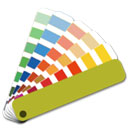In the end, you may get something printed beautifully that is a close, but not exact match.
An interesting thing has been coming up lately: how to deal with identity standards. Specifically, colour in relation to identity standards. Many of our clients are now in possession of thorough identity standards manuals produced by ourselves, or by another agency such as Focus Design Group. These guides give specific information about what colours can be used, what size logos should be and what colour the logo should be in various applications.
 Let’s start by emphasizing that these manuals are invaluable tools for central Alberta companies to use in managing their brand.
Let’s start by emphasizing that these manuals are invaluable tools for central Alberta companies to use in managing their brand.
Let’s continue by de-bunking some myths that might arise while using such a tool.
Imagine you’ve just gone through the process of creating a brand, watching it grow and develop, learning about it, and seeing it come to life. Then imagine being handed a cd, a pdf of guidelines and sent on your merry way to bring that brand to the world. Very exciting!
Now imagine your dismay to see boxes of printing delivered to your door with out matching your ID guide.
What you likely did:
- You probably got the appropriate files and the ID guide with the standards to the service provider (a designer or a print shop);
- You probably assumed they’s use the appropriate colours & follow rules outlined in the guide; and
- You probably saw proofs either via email or laser prints–two mediums that have almost no hope of matching true printed output.
What they likely did:
- They probably read the colour information and input the appropriate information into their software;
- They probably quickly reviewed a swatchbook to see the match was close; and
- They probably output a final product to the best of their ability.
So what happed? The answer is not a simple one, I’m afraid. Many things affect printing output. Sadly most of the factors can reduce the most diligently produced product to a close match to a standard at best. Several factors will affect the output:
- The paper stock affects the output–uncoated stocks are often a bit lighter in hue and darkness than coated stock;
- The pressman had to mix the ink using a formula–since it is often done by hand, there will a difference from job to job, though for larger projects printers often order the ink pre-mixed; and
- Different shops pay more or less attention to these types of matches unless explicitly told to do so.
In the end, you may get something printed beautifully that is a close, but not exact match. This should usually be counted as a victory, given the non-exact nature of the design & print industry. Keep in mind that if you want the closest match possible, always, always provide a sample to match to, and always, always emphasize at all stages that the match is critically important. Ensuring the suppliers know is your best tool for accuracy. And then be prepared for variations in stock and ink mix and bad weather and all sorts of things to throw monkey wrenches into the process.
Here at Redpoint we always pay attention to the colour numbers and try our best to match everything we can, and I’m not saying clients should accept anything, but the more attention paid to the standards (and the emphasis put in them) will result in more accurate results. If you want a match, make sure you bring it up with us.
